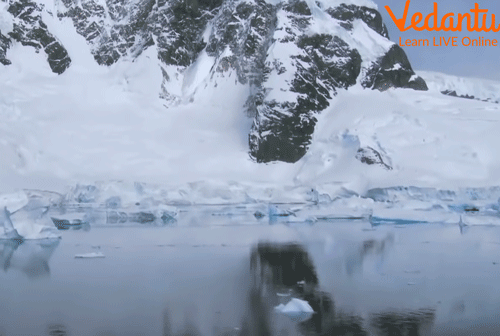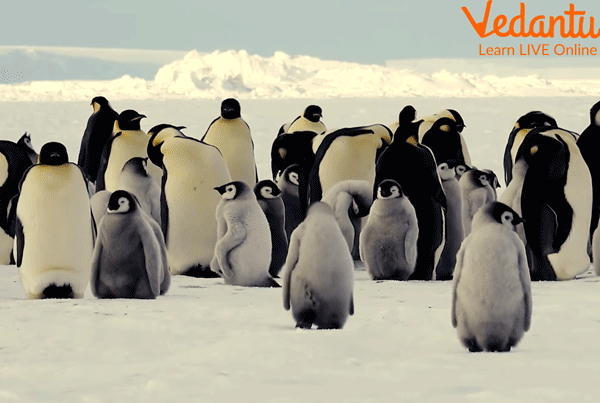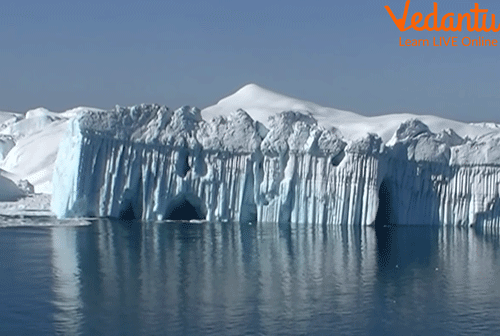




Overview of Antarctica
Here we are going to learn about the cold and beautiful places of Antarctica. The continent of Antarctica makes up most of the Antarctic region. Antarctica is a remote, cold area in the Southern Hemisphere within the Antarctic Convergence. The Antarctic Convergence is an uneven line of latitude where cold, northward-flowing Antarctic waters meet the warmer waters of the world’s oceans. The Antarctic comprises approximately 20 percent of the Southern Hemisphere.
Antarctica is the fifth-largest continent in terms of area. It is larger than both Oceania and Europe combined. Antarctica is a unique continent because it has no native population. Although seven nations claim portions of it, there are no countries in Antarctica. Here, we will learn various important facts about Antarctica for kids and the features of Antarctica.

An Image Showing Antarctica’s Ice
Physical Features of Antarctica
The region is dominated by the Antarctic Ice Sheet. It is the single biggest chunk of ice known to exist. From roughly 3 million square kilometres (1.2 million square miles) at the end of summer to about 19 million square kilometres (7.3 million square miles) by winter. The Ross Ice Shelf and the Ronne Ice Shelf are the two coastal ice shelves where ice sheet expansion largely takes place.
The Transantarctic Mountains, which separate the continent's eastern and western portions, are one of the many peak tops in Antarctica. Several of these summits are over 4,500 metres in elevation (14,764 feet). The Antarctic Ice Sheet itself is located at the heart of the continent, where it rises to a height of 4,000 metres (13,123 feet) above sea level. Its elevation is around 2,000 metres (6,562 feet).
Older igneous and metamorphic rocks make up East Antarctica, often known as Greater Antarctica. Younger, volcanic, and sedimentary rocks make up West Antarctica, often known as Lesser Antarctica. In reality, the "Ring of Fire," a tectonically active region around the Pacific Ocean, includes Lesser Antarctica.
An essential physical feature of the Antarctica area is provided by the waters that surround Antarctica. The depth of the oceans surrounding Antarctica ranges from 13,123 to 16,404 feet (4,000 to 5,000 metres).

Penguins in Antarctica
First Sightings of Antarctica
The history of Antarctica dates back to the Greeks. Antarctica was originally far further north and had a tropical or semi-tropical climate, even though it is today a frozen wasteland. There, life abounded and forests bloomed.
Aristotle said that because the earth is spherical, there must be a landmass in the south to balance the land in the north. European navigators could not explore the Antarctic until the 18th century. He was assigned to a mission to the Southern Hemisphere between 1772 and 1775. Cook was the first person to traverse the Antarctic circle on January 17, 1773. He went over it.
An Estonian called Fabian von Bellinngsingshausen was the first person to view the continent of Antarctica on January 27, 1820. On January 30, 1820, Edward Bransfield became the second person to visit Antarctica. The South Orkney Islands were later found by George Powell and Nathaniel Palmer on December 6, 1821.
James Weddell, a Scot, also investigated the Weddell Sea in 1823. Charles Wilkes, an American, explored Antarctica in 1838–1839; Dumont d'Urville, a Frenchman, explored it in 1837–1840; and James Ross, a Scot, explored it in 1839–1841 The Ross Sea and Ross Ice Shelf were found by the latter.
Then, in 1892–1894, Carl Larson, a Norwegian, sailed to the southern continent. The first proof that Antarctica originally had a significantly warmer temperature was found by him—fossil wood. The Possession Islands were home to lichens when another Norwegian, Henrik Bull, discovered them in 1895.
Then, Adrien de Gerlache, a Belgian, conducted a second Antarctic trip in 1897–1898. Carsten Borchgrevink, a Norwegian, led a party of men that spent the winter in Antarctica from 1899–1900. They demonstrated that it was feasible to endure the brutal Antarctic winter. They were the first to bring dogs to Antarctica as well.

Iceberg in Antarctica
Climate of Antarctica
The climate of Antarctica is cold. The average yearly temperature in Antarctica varies from around 10°C along the shore to roughly 60°C in the interior's highest elevations.
The temperature can rise beyond +10°C in the summer and drop below 40°C in the winter close to the shore. It may go up to roughly 30°C over the higher inland in the summer but drop below 80°C in the winter.
The lowest temperature ever measured on the surface of the Earth was 89.2°C on July 21, 1983, at Vostok station.
A band of low pressure that has several low centres often encircles Antarctica. The phrase "circumpolar trough" describes this. But there is considerable pressure across the continent's interior. These circumstances create the ideal environment for Katabatic winds to emerge. Over a wide region, katabatic winds are quite consistent. They lose their energy near the coast and quickly evaporate offshore.
Summary
Antarctica is a colder region. When the air becomes extremely cold and dense due to radiative cooling over the high Antarctic ice sheet, Katabatic winds are produced. As it descends, the chilly, thick air is replaced with air that is subsiding from above. The meeting of glacier valleys causes the Katabatic winds to speed up and blow downward. The Transantarctic Mountains are one of the most beautiful places in Antarctica. Penguins are present in a good amount here in Antarctica.
Antarctica is made up of older igneous and metamorphic rocks. There is a temperature rise beyond +10°C in the summer and a drop below 40°C in the winter season near the shore. This makes Antarctica a unique place. Features of Antarctica, history of Antarctica, and climate of Antarctica.
FAQs on Important Facts about Antarctica for Kids
1. What are some of the island territories of Antarctica?
Antarctica also includes island territories within the Antarctic Convergence. The islands of the Antarctic region are the South Orkney Islands, the South Shetland Islands, South Georgia, and the South Sandwich Islands, all claimed by the United Kingdom; Peter I Island and Bouvet Island, claimed by Norway; Heard and McDonald Islands, claimed by Australia; and Scott Island and the Balleny Islands, claimed by New Zealand.
2. What are blizzards in Antarctica?
Blizzard conditions include wind gusts of at least gale force for at least one hour, temperatures below zero, and limited visibility of 100 metres or less. Outdoor activities are unsafe and difficult under these circumstances. Blizzards may occasionally linger for days.
3. What is whiteout in Antarctica?
Whiteout is an optical phenomenon. It may be hard to discern between shadows, landmarks, or the horizon in uniform lighting circumstances. When the snow has completely covered the area and the sky is cloudy, this might occur. Whiteout is a dangerous situation because it impairs vision and sense of direction.









